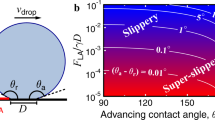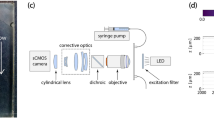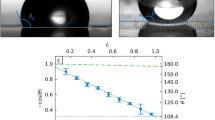Abstract
With the important development of microfluidic systems, miniaturization of flow devices has become a real challenge. Microchannels, however, are characterized by a large surface-to-volume ratio, so that surface properties strongly affect flow resistance in submicrometre devices. We present here results showing that the concerted effect of wetting properties and surface roughness may considerably reduce friction of the fluid past the boundaries. The slippage of the fluid at the channel boundaries is shown to be greatly increased by using surfaces that are patterned on the nanometre scale. This effect occurs in the regime where the surface pattern is partially dewetted, in the spirit of the 'superhydrophobic' effects that have been discovered at macroscopic scales1. Our results show for the first time that, in contrast to common belief, surface friction may be reduced by surface roughness. They also open the possibility of a controlled realization of the 'nanobubbles'2 that have long been suspected to play a role in interfacial slippage3,4.
This is a preview of subscription content, access via your institution
Access options
Subscribe to this journal
Receive 12 print issues and online access
$259.00 per year
only $21.58 per issue
Buy this article
- Purchase on Springer Link
- Instant access to full article PDF
Prices may be subject to local taxes which are calculated during checkout




Similar content being viewed by others
References
Quéré, D. Fakir droplets. Nature Mater. 1, 14–15 (2002).
Tyrell, J.W.G. & Attard, P. Images of nanobubbles on hydrophobic surfaces and their interactions. Phys. Rev. Lett. 87, 176104 (2001).
Vinogradova, O.L. et al. Submicrocavity structure of water between hydrophobic and hydrophilic walls as revealed by optical cavitation. J. Colloid Interface Sci. 173, 443–447 (1995).
de Gennes, P.G. On fluid/wall slippage. Langmuir 18, 3413–3414 (2002).
Schnell, E. Slippage of water over nonwettable surfaces. J. Appl. Phys. 27, 1149–1152 (1956).
Churaev, N.V., Sobolev, V.D. & Somov, A.N. Slippage of liquids over lyophobic solid-surfaces. J. Colloid Interface Sci. 97, 574–581 (1984).
Chan, D.C.Y. & Horn, R.G. The drainage of thin liquid-films between solid-surfaces. J. Chem. Phys. 83, 5311–5324 (1985).
Georges, J.-M., Millot, S., Loubet, J.-L. & Tonck, A. Drainage of thin liquid-films between relatively smooth surfaces. J. Chem. Phys. 98, 7345–7360 (1993).
Baudry, J., Charlaix, E., Tonck, A. & Mazuyer, D. Experimental evidence for a large slip effect at a nonwetting fluid-solid interface. Langmuir 17, 5232–5236 (2001).
Craig, V.S.J., Neto, C. & Williams, D.R.M. Shear-dependent boundary slip in an aqueous Newtonian liquid. Phys. Rev. Lett. 87, 054504 (2001).
Zhu, Y.X. & Granick, S. Limits of the hydrodynamic no-slip boundary condition. Phys. Rev. Lett. 88, 106102 (2002).
Cottin-Bizonne, C. et al. An experimental study of slipping length. Eur. Phys. J. E 9, 47–53 (2002).
Pit, R., Hervet, H. & Léger, L. Direct experimental evidence of slip in hexadecane: Solid interfaces. Phys. Rev. Lett. 85, 980–983 (2000).
Tretheway, D.C. & Meinhart, C.D. Apparent fluid slip at hydrophobic microchannels walls. Phys. Fluids 14, L9–L12, (2002).
Thompson, P.A. & Robbins, M.O. Shear flow near solids – Epitaxial order and flow boundary conditions. Phys. Rev. A 41, 6830–6837 (1990).
Barrat, J.-L. & Bocquet, L. Large slip effect at a nonwetting fluid-solid interface. Phys. Rev. Lett. 82, 4671–4674 (1999).
Barrat, J.-L. & Bocquet, L. Influence of wetting properties on the hydrodynamic boundary condition at a fluid-solid interface. Faraday Discuss. 112, 121–129 (1999).
Lauga, E. & Stone H.A. Effective pressure-driven Stokes flow. J. Fluid Mech. (in the press).
Richardson, S. No slip boundary condition. J. Fluid Mech. 59, 707–719 (1973).
Watanabe, K., Udagawa, Y. & Ugadawa, H. Drag reduction of Newtonian fluid in a circular pipe with a highly water-repellent wall. J. Fluid Mech. 381, 225–238 (1999).
Hocking, L.M. A moving fluid interface on a rough surface. J. Fluid Mech. 76, 801–817 (1976).
Kim, J. & Kim, C.J. Nanostructured surfaces for dramatic reduction of flow resistance in droplet based microfluidics. Proc. 2002 IEEE Conf. MEMS, Las Vegas, Nevada (in the press).
Acknowledgements
It is a pleasure to thank H.A. Stone for interesting discussions. We thank the DGA for its financial support, and the PSMN (ENS-Lyon) and CDCSP (University of Lyon) for the use of their computational facilities.
Author information
Authors and Affiliations
Corresponding author
Ethics declarations
Competing interests
The authors declare no competing financial interests.
Rights and permissions
About this article
Cite this article
Cottin-Bizonne, C., Barrat, JL., Bocquet, L. et al. Low-friction flows of liquid at nanopatterned interfaces. Nature Mater 2, 237–240 (2003). https://doi.org/10.1038/nmat857
Received:
Accepted:
Published:
Issue Date:
DOI: https://doi.org/10.1038/nmat857
This article is cited by
-
The influence of slip boundary effect on the propagation of shear horizontal guided waves in a fluid-saturated porous medium
Journal of Engineering Mathematics (2024)
-
Thin superhydrophobic layers on the SiC powder surface toward electrical erosion resistance
Journal of Materials Science: Materials in Electronics (2023)
-
Interfacial friction at action: Interactions, regulation, and applications
Friction (2023)
-
Unraveling the liquid gliding on vibrating solid liquid interfaces with dynamic nanoslip enactment
Nature Communications (2022)
-
Insights from molecular simulations on liquid slip over nanostructured surfaces
Journal of Molecular Modeling (2022)



